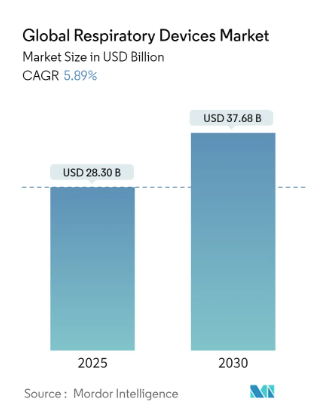Mordor Intelligence has published a new report on the Respiratory Devices Market, offering a comprehensive analysis of trends, growth drivers, and future projections.
The global respiratory devices market is on a significant growth trajectory, with projections indicating an increase from USD 28.30 billion in 2025 to USD 37.68 billion by 2030, reflecting a compound annual growth rate (CAGR) of 5.89% during this period. This expansion is primarily attributed to the escalating prevalence of respiratory disorders such as chronic obstructive pulmonary disease (COPD), tuberculosis (TB), asthma, and sleep apnea, coupled with technological advancements in respiratory care devices.
Key Trends
Increasing Prevalence of Respiratory Disorders
The global burden of respiratory diseases is rising, driven by factors such as air pollution, tobacco smoking, occupational hazards, and respiratory infections. For instance, the American Lung Association reported that in 2022, 44.2 million Americans were diagnosed with asthma, representing 13.5% of the population. Additionally, tuberculosis cases in the United States increased from 8,320 in 2022 to 9,615 in 2023, highlighting a growing need for effective respiratory care solutions.
Technological Advancements in Respiratory Devices
The respiratory devices market has witnessed significant technological innovations aimed at enhancing patient care and improving device efficiency. The development of portable and user-friendly devices, such as advanced ventilators and CPAP machines, has improved patient compliance and expanded the market. For example, in August 2024, Inspire Medical Systems secured FDA approval for its Inspire V neurostimulator therapy, designed for obstructive sleep apnea (OSA).
Impact of COVID-19 Pandemic
The COVID-19 pandemic has underscored the critical importance of respiratory devices in managing respiratory complications associated with the virus. The increased demand for ventilators, oxygen concentrators, and other respiratory support devices during the pandemic has accelerated market growth and highlighted the need for robust respiratory care infrastructure.
Report Overview: https://www.mordorintelligence.com/industry-reports/global-respiratory-device-market-industry
Market Segmentation
By Type
- Diagnostic and Monitoring Devices:
- Spirometers: Devices that measure lung function, essential for diagnosing conditions like asthma and COPD.
- Sleep Test Devices: Used to diagnose sleep-related breathing disorders, including sleep apnea.
- Peak Flow Meters: Portable devices that measure the patient’s maximum speed of expiration, useful in asthma management.
- Pulse Oximeters: Non-invasive devices that monitor oxygen saturation levels in the blood.
- Capnographs: Devices that measure the concentration of carbon dioxide in exhaled air, indicating respiratory status.
- Therapeutic Devices:
- CPAP Devices: Continuous Positive Airway Pressure devices used primarily for sleep apnea treatment.
- BiPAP Devices: Bilevel Positive Airway Pressure devices offering two levels of pressure for patients with more complex respiratory conditions.
- Humidifiers: Devices that add moisture to the air, aiding patients with dry respiratory passages.
- Nebulizers: Convert liquid medication into a mist for inhalation, commonly used in asthma and COPD treatment.
- Oxygen Concentrators: Provide supplemental oxygen to patients with respiratory disorders.
- Ventilators: Machines that support or take over the breathing process for patients unable to breathe adequately on their own.
- Inhalers: Portable devices delivering medication directly to the lungs, essential in asthma and COPD management.
- Disposables:
- Masks: Various types, including nasal and full-face masks, used with ventilators and CPAP devices.
- Breathing Circuits: Tubing systems that deliver air or oxygen from the machine to the patient.
By End User
- Hospitals: Primary centers for acute respiratory care, utilizing a wide range of respiratory devices.
- Respiratory Clinics: Specialized centers focusing on the diagnosis and treatment of respiratory disorders.
- Other End Users: Includes home healthcare settings, long-term care facilities, and emergency medical services.
By Geography
- North America: Currently the largest market, driven by a high prevalence of respiratory diseases, advanced healthcare infrastructure, and significant healthcare expenditure.
- Europe: Holds a substantial market share due to increased awareness, supportive government initiatives, and a growing elderly population.
- Asia-Pacific: Anticipated to be the fastest-growing region, attributed to rising pollution levels, increasing smoking rates, and improving healthcare access.
- Middle East and Africa: Emerging markets with growing investments in healthcare infrastructure and increasing prevalence of respiratory disorders.
- South America: Experiencing gradual growth due to expanding healthcare access and rising incidence of respiratory diseases.
Get a Customized Report Tailored to Your Requirements. – https://www.mordorintelligence.com/market-analysis/diagnostics-and-therapeutics
Key Players
The respiratory devices market is characterized by the presence of several key players contributing to its competitive landscape. Notable companies include:
- Drägerwerk AG: A leading manufacturer of medical and safety technology products, including advanced respiratory devices.
- Fisher & Paykel Healthcare Limited: Specializes in innovative respiratory care solutions, including humidifiers and CPAP devices.
- GE Healthcare: Provides a comprehensive range of medical technologies, including respiratory monitoring and diagnostic devices.
- Invacare Corporation: Offers a wide array of home healthcare products, including oxygen concentrators and respiratory therapy devices.
- ResMed Inc.: Focuses on developing devices and cloud-connected solutions for respiratory disorders, particularly sleep apnea.
Conclusion
The respiratory devices market is set for sustained growth, driven by rising respiratory disorders, technological advancements, and increased demand for home-based healthcare solutions. As the global population ages and environmental factors continue to impact respiratory health, the need for effective respiratory devices will only increase.
Companies that invest in innovation, portability, and digital connectivity are well-positioned to capitalize on the growing demand for respiratory care solutions. The market’s future will be shaped by advancements in non-invasive ventilation, remote patient monitoring, and personalized respiratory therapies, ensuring better outcomes for patients worldwide.
Indutsry Related Reports

